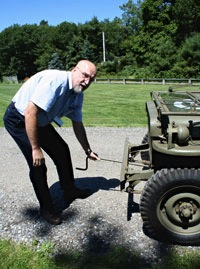The first thing you notice is the smell, that unmistakably musty aroma of WWII-era canvas. The seat cushions are the real deal too—Army blankets folded into a perfect square (not great padding on potholes).
Rene Bernier hops into his 1942 Ford GPW Jeep and whirrs out of the parking lot like he’s been driving old Army Jeeps all his life. In fact, he nearly has.
A self-professed “gear head,” Bernier, of Brunswick, Me., got his first Jeep when he was a teenager (“I needed wheels and it was cheap.”) Several decades and six Jeeps later, Bernier is recognized as among the top restorers of military vehicles in the country. One of his restored Jeeps was purchased by the Coles Transportation Museum in Bangor.
Bernier’s current Jeep just won gold in its class at the Military Vehicle Preservation Association’s National Convention and Bernier himself was awarded the MVPA Service Award for contributions to the hobby.
But is is the addition of some irreplaceable human testimonials that puts Bernier’s Jeep in a class all its own.
“Our goal in restoration is, if you were to go back in time to 1943, the guy running the motor pool would go, yup, just like every other one he’s seen. It’s absolutely accurate,” says Bernier.
Without much provocation, he snaps off the top and pops open the hood. The original engine includes nifty features such as a flip-up headlamp for tinkering on the engine at night. Bolt heads bear the distinguishing letter “F,” for Ford, as does the fan belt, which is marked Ford GPW (“Had to have that made,” he says in a raspy voice just made for a Jeep.).
Just for fun, he demonstrates the hand-crank starter, which sets the Jeep purring with a single stroke.
 Her name is “Sweetpea,” painted in wavery script above the rear wheel deck. The vehicle came from a barn in Bowdoin, Me., rusted and covered in 12 layers of paint. Bernier estimates he has spent more than 600 hours in its restoration, wielding both welding torch and paint brush.
Her name is “Sweetpea,” painted in wavery script above the rear wheel deck. The vehicle came from a barn in Bowdoin, Me., rusted and covered in 12 layers of paint. Bernier estimates he has spent more than 600 hours in its restoration, wielding both welding torch and paint brush.
“Holy cow, there’s no logical explanation why anyone would do this stuff,” Bernier says, grinning broadly. “It’s just an obsession.”
“Sweetpea” is historically significant for another reason. In his travels along parade routes, auto shows, and even around town, Bernier has encountered WWII veterans. He always invites them to take a ride.
“This is where I have WWII veterans sign.” Bernier points to the dashboard, which bears penned inscriptions by eight former WWII soldiers who lived to tell their tales.
The first name is Bob Coffin, of Coffin Street in Brunswick, Me., who was Bernier’s first veteran passenger. Coffin was wounded in France July 24, 1944. He wrote: “It is so good to be alive, even now.”
Bernier likes to tell the story about Coffin: “I asked him, ‘Well, this must bring back memories, riding in a jeep.’ He says, ‘No sonny, this is the first time I ever rode in a Jeep. They made us walk everywhere.”
“I give them a little space and tell them, ‘Write whatever you want. Write what you remember,’ ” says Bernier.
With just a few words, the veterans’ entries evoke a staggering range of experience. A faded entry by U.S.N. Coxswain Conrad LeBourdais, who served aboard a landing craft in the Pacific arena cites the date Sept. 3, 1945. It simply says: “Saw the sight.” It was 25 days after the nuclear bomb at Hiroshima.
“They live down the street from me,” marvels Bernier. “I mean, people you know have seen the aftermath of a nuclear explosion. Never said a word to me about it till then.”
 In his other life, Bernier has spent over a quarter century teaching Bowdoin students in Intro Chemistry labs. He also is lab manager for the science center. One good crossover between his two endeavors, he says: “I understand what chemicals will remove old paint …”
In his other life, Bernier has spent over a quarter century teaching Bowdoin students in Intro Chemistry labs. He also is lab manager for the science center. One good crossover between his two endeavors, he says: “I understand what chemicals will remove old paint …”
Bernier is featured in the current edition of Motor Trend Classic magazine and is author of the self-published book, WWII Jeep Guidebook: Buying Owning and Enjoying Your WWII Jeep.
Published in Bowdoin Magazine.
